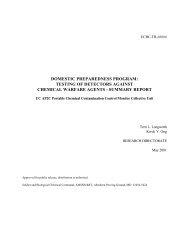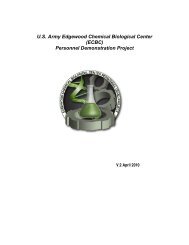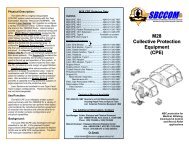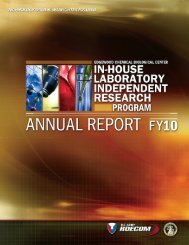(FFPE) with Self-Contained Breathing Apparatus (SCBA) for Rescue
(FFPE) with Self-Contained Breathing Apparatus (SCBA) for Rescue
(FFPE) with Self-Contained Breathing Apparatus (SCBA) for Rescue
Create successful ePaper yourself
Turn your PDF publications into a flip-book with our unique Google optimized e-Paper software.
AGENT<br />
Nerve Agents<br />
APPENDIX C<br />
Signs and Symptoms of Chemical Agent Exposure<br />
SIGNS AND<br />
SYMPTOMS<br />
Chemical Agents<br />
DECONTAMINATION PERSISTENCE PHYSICAL<br />
STATE<br />
Tabun GA Salivation<br />
Remove contaminated clothing 1-2 days if heavy Liquid<br />
Sarin GB<br />
Lacrimation<br />
Urination<br />
Flush <strong>with</strong> a soap and water<br />
solution <strong>for</strong> patients<br />
concentration<br />
1-2 days will evaporate Liquid<br />
Soman GD<br />
Defecation<br />
Gastric disturbances<br />
Flush <strong>with</strong> large amounts of a<br />
5% bleach and water solution <strong>for</strong><br />
<strong>with</strong> water<br />
Moderate, 1-2 days Liquid<br />
V Agents<br />
VX Emesis<br />
objects<br />
High, 1 week if heavy<br />
concentration. As<br />
volatile as motor oil<br />
Liquid<br />
Vesicants (Blister Agents)<br />
Sulfur Mustard H<br />
Distilled Mustard HD<br />
Nitrogen Mustard HN 1,3<br />
Mustargen HN2<br />
Acts first as a cell irritant, then<br />
as a cell poison. Conjunctivitis,<br />
reddened skin, blisters, nasal<br />
irritation, inflammation of throat<br />
and lungs.<br />
Lewisite L Immediate pain <strong>with</strong> blisters<br />
later.<br />
Phosgene Oxime CX Immediate pain <strong>with</strong> blisters<br />
later – necrosis equivalent to<br />
second- and third-degree burns<br />
Chemical Asphyxiants (Blood agents)<br />
Remove contaminated clothing<br />
Flush <strong>with</strong> soap and water<br />
solution <strong>for</strong> patients.<br />
Flush <strong>with</strong> large amounts of a<br />
5% bleach and water solution <strong>for</strong><br />
objects<br />
Very high, days to<br />
weeks<br />
Moderate<br />
Days, rapid hydrolysis<br />
<strong>with</strong> humidity<br />
Low, 2 hours in soil<br />
Hydrogen Cyanide AC Cherry red skin or ~ 30% Remove contaminated clothing. Extremely volatile Gas<br />
Cyanogen Chloride CK cyanosis. Patients may appear to<br />
be gasping <strong>for</strong> air. Seizures<br />
prior to death. Effect is similar<br />
to asphyxiation, but is more<br />
sudden.<br />
Flush <strong>with</strong> a soap and water<br />
solution <strong>for</strong> patients.<br />
Flush <strong>with</strong> large amounts of 5%<br />
bleach and water solution <strong>for</strong><br />
objects.<br />
Rapidly evaporates and<br />
disperses<br />
Gas<br />
Liquid<br />
Liquid<br />
Liquid<br />
Solid<br />
Table C1. Chemical Agent In<strong>for</strong>mation<br />
After exposure to chemical agents, victims may present one or more of the symptoms described<br />
by the mnemonic “SLUDGE.” The table on the following page associates specific signs and<br />
symptoms <strong>with</strong> specific chemical agents.<br />
Determining from signs and symptoms alone that a victim has been exposed to a chemical agent<br />
can be difficult <strong>for</strong> a first responder. In general, at least two signs or symptoms should be<br />
present to limit the risk of mistaking exposure to less toxic substances <strong>with</strong> exposure to chemical<br />
agents.<br />
C-1
















